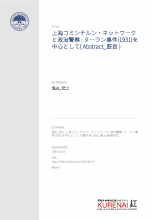4 0 0 0 OA 上海コミンテルン・ネットワークと政治警察 : ヌーラン事件(1931)を中心として
- 著者
- 鬼丸 武士
- 出版者
- 京都大学 (Kyoto University)
- 巻号頁・発行日
- 2005-03-23
新制・課程博士
2 0 0 0 OA 新興国の政治と経済発展の相互パターンの解明
- 著者
- 園部 哲史 戸堂 康之 白石 隆 大塚 啓二郎 佐藤 寛 杉原 薫 恒川 惠市 鬼丸 武士 松本 朋哉 高木 佑輔 本名 純
- 出版者
- 政策研究大学院大学
- 雑誌
- 新学術領域研究(研究領域提案型)
- 巻号頁・発行日
- 2013-06-28
研究期間全体を通じて、経済学者、政治学者と歴史学者が協力しながら、現在の新興国の政治と経済についての実証分析を行った。総括班は、各計画研究班の共同研究を行う場を提供し、分野融合マインドを持った若手研究者の育成にも力を入れた。その結果、新興国に独自の発展経路の在り方や、それに基づく新興国の課題の存在が解明された。領域全体の活動成果として、世界的な学術書の出版社であるSpringer Nature社のシリーズEmerging-Economy State and International Policy Studiesを新たに作り出し、本領域の成果を4巻からなる英文書籍として出版することになった。
1 0 0 0 OA 近代アジアにおける越境する革命家の「旅」と都市
- 著者
- 鬼丸 武士
- 出版者
- 一般財団法人 日本国際政治学会
- 雑誌
- 国際政治 (ISSN:04542215)
- 巻号頁・発行日
- vol.2018, no.191, pp.191_64-191_79, 2018-03-28 (Released:2018-12-19)
- 参考文献数
- 48
From mid-19th century onwards, the world was increasingly connected by modern modes of transportation and technologies of communication, such as railways, steamships, modern banking systems, the telegraph, and so on. In East and Southeast Asia, the highest degrees of connectivity were found in and between the capitals or maritime port cities, including Tokyo, Yokohama, Kobe, Nagasaki, Shanghai, Canton, Hong Kong, Manila, Saigon, Bangkok, Singapore, Batavia, and Rangoon. These cities were linked by steamship, rail, and telegraph services, and covered with networks extending the flows of people, commodities, money, and information. That era of deepening regional connectivity and flows in East and Southeast Asia corresponded with the peak of political revolutionary movements grounded in nationalism, communism, religion, or anti-colonialism. Colonial and national governments regarded these movements as threats, and closely monitored and severely suppressed political activists. Under such circumstances, many revolutionaries were forced into exile by arrest and deportation or in order to escape detention. Exiled activists regularly moved between different cities connected by modern transportation and communication technologies. The cities served as their bases from which they partook of many itineraries of revolutionary activity abroad. This paper focuses on the itineraries of three famous Asian revolutionaries, namely, Sun Yat-sen, Nguyen Ai Quoc, and Tan Malaka, who lived in exile from 1895 to 1916, from 1911 to 1941, and from 1922 to 1942 respectively. The paper offers a comparative study of the particular cities in which these exiled revolutionaries based or pursued their political movements, and explains why these cities were chosen for their arenas of revolutionary activity. Between them, the exiles lived and operated in Tokyo/Yokohama, Shanghai, Manila, Amoy, Canton, Hong Kong, Hanoi, Bangkok, Singapore, and Penang. These were the major maritime cities of Asia, serving as national or colonial state capitals or the leading trading centers in the region. Besides the advantage of having regular services of steamships and communication technologies at hand, the revolutionaries had differing reasons for selecting cities for their revolutionary headquarters. For example, Sun Yat-sen frequently visited and stayed in Tokyo/Yokohama because of his links with Japanese politicians, entrepreneurs, and supporters. On the other hand, Shanghai was the preferred city of underground revolutionaries, such as Tan Malaka, because Shanghai was divided into three municipalities. In short, a close understanding of the relations between cities and revolutionary movements requires a careful analysis of the political, economic, social, and historical background and character of the cities themselves.
- 著者
- 鬼丸 武士
- 出版者
- 京都大学東南アジア地域研究研究所
- 雑誌
- 東南アジア研究 (ISSN:05638682)
- 巻号頁・発行日
- vol.40, no.4, pp.502-519, 2003-03-31 (Released:2017-10-31)
In the nineteenth century, Britain possessed two important bases for its “free trade policy” in Southeast and East Asia—Singapore and Hong Kong. The success of the British free trade policy in these regions hinged on their ability to make Singapore and Hong Kong flourish. To achieve this end, the colonial governments had to overcome two obstacles: the problem of raising revenue and the maintenance of public order. As both Singapore and Hong Kong were free ports, the colonial governments were prevented from collecting revenue through tariffs. Thus, somehow they had to obtain revenue from the local populace, which in both cases was mainly Chinese. With respect to public order, both administrations had to deal with crimes, riots, and strikes engaged in by the Chinese. In this paper, I try to reveal how the British colonial governments in Singapore and Hong Kong dealt with these issues of revenue raising and policing. In terms of revenue-raising, I examine the importance of the opium farming system under the two administrations; with regard to public order, I investigate how the Chinese secret societies were policed. By comparing practices in these colonies, I aim to describe the character of colonial rule in Singapore and Hong Kong and how it reflected the British “free trade policy.”
1 0 0 0 IR 上海コミンテルン・ネットワークと政治警察 : ヌーラン事件(1931)を中心として
- 著者
- 鬼丸 武士
- 出版者
- 京都大学東南アジア研究所
- 雑誌
- 東南アジア研究 (ISSN:05638682)
- 巻号頁・発行日
- vol.43, no.3, pp.303-318, 2005-12-31
この論文は国立情報学研究所の学術雑誌公開支援事業により電子化されました。
